Celebrating Popeye the Sailor Man’s 90 Years in Animation!
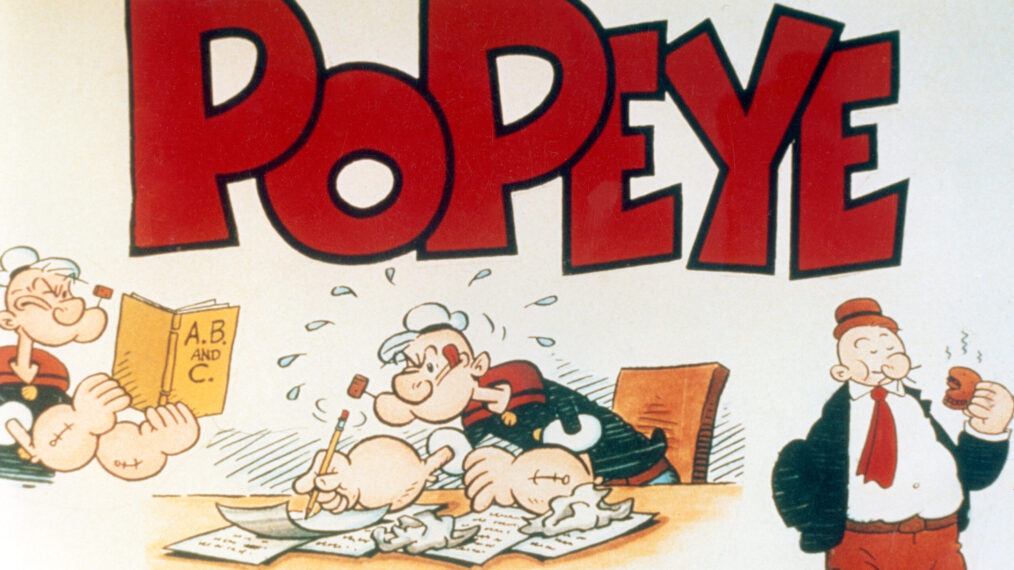
Popeye the Sailor Man fights for the downtrodden with his fists and heart. In print and on screen he’s often seen donating money to a children’s orphanage. Several of his cartoons end with him singing a song with a moral. For example: Jus’ cause yer taller don’t hit someone smaller, says Popeye the Sailor Man.
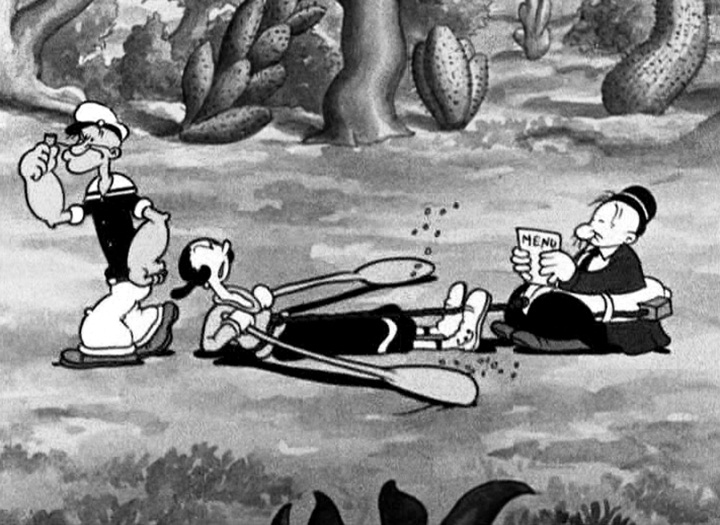
©King Features Syndicate and from the Personal Collection of Fred Grandinetti.
I Yam What I Yam, produced in 1933 by the Fleischer Studios, was the first entry in Popeye’s short subject series for theaters.
Popeye is not flashy like Bugs Bunny or Daffy Duck. Consequently, his achievements have often been overlooked by the media, but not by his huge following.
On July 14th, 2023, the scrappy sailor man celebrates the 90th anniversary of his debut in animated cartoons. Popeye went on to star in the longest-running animated short series, with 234 episodes. Since his film debut in a 1933 Betty Boop cartoon titled Popeye the Sailor, his animated films have aired continuously all around the globe. In the United States, MeTV airs Popeye’s theatrical shorts, and they can also be seen on YouTube in different languages.
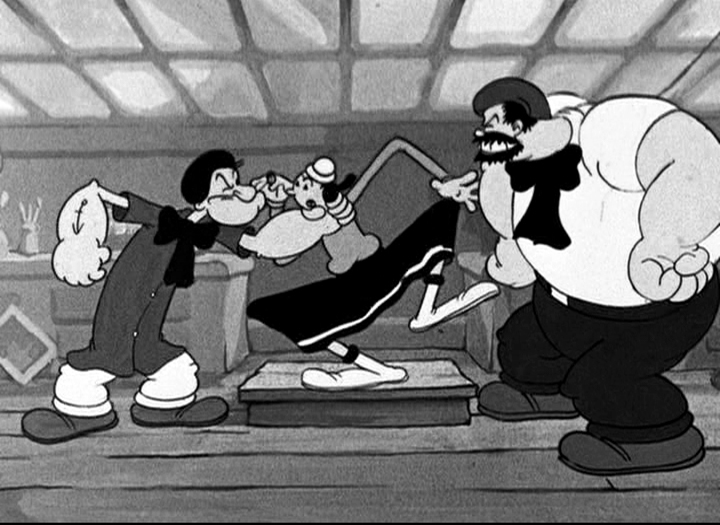
©King Features Syndicate and from the Personal Collection of Fred Grandinetti.
Olive Oyl is caught in the middle between artists Popeye and Bluto in My Artistical Temperature (Fleischer, 1937)
Popeye began his life on January 17, 1929 in the comic strip Thimble Theatre by E.C. Segar. The scrappy sailor was intended for only one story. The newspaper-reading public wanted to see more of the character, so Segar brought him back to the funny pages.
Fleischer Studios produced animated films with a grittier look depicting the streets of New York. Betty Boop was born from this era and Max Fleischer, who was a big fan of Segar’s strip, plucked Popeye, his girlfriend Olive Oyl and the brute, Bluto, from the comics page and into one of Betty’s theatrical cartoons. Due to the success of Popeye’s screen debut the sailor’s own series began three months later.
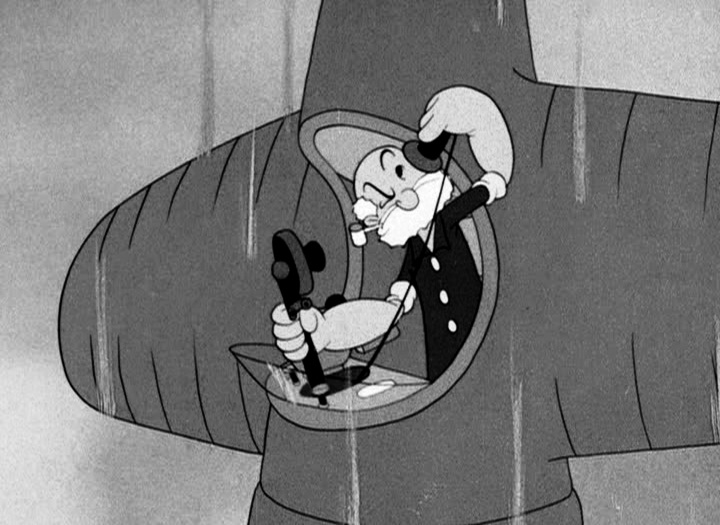
©King Features Syndicate and from the Personal Collection of Fred Grandinetti.
With his plane headed downward Poopdeck Pappy calls for help in Pest Pilot (Fleischer, 1941)
The Fleischer-produced Popeye cartoons featured shadows, texture, three-dimensional backgrounds and rousing musical scores. They are best remembered for the ad libs provided by the voice actors. William Costello, known as Red Pepper Sam, was the original gruff sounding voice of Popeye. When success went to his head, the Fleischers replaced him with studio artist Jack Mercer. Bonnie Poe, Mae Questel and Margie Hines provided the voice of Olive Oyl. Gus Wickie and Pinto Colvig are best remembered as the voice of Bluto. Segar’s other fantastic comic strip characters made their animation debuts in the black-and-white Fleischer films: J. Wellington Wimpy, the hamburger moocher; Swee’pea, Popeye’s adopted son; Eugene the Jeep, the magical creature from the 4th dimension; Poopdeck Pappy, Popeye’s hard-to-handle father; and the monstrous Goons!
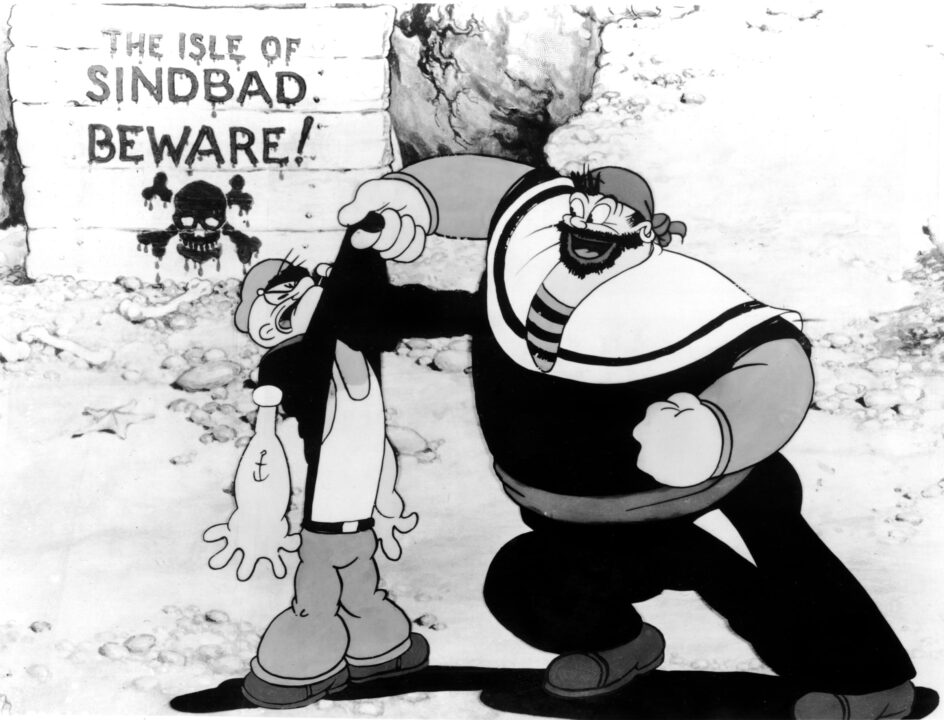
Everett Collection
In 1936, Popeye starred in the first of three two-reel color films, Popeye the Sailor Meets Sindbad the Sailor. The film earned an Academy Award nomination, but was beaten by a short from the Walt Disney Studios. However, Popeye would get his revenge on Disney when it was announced the sailor’s popularity outdistanced Disney’s Mickey Mouse.
Many tend to think the plots in the sailor man series dealt mainly with Popeye and Bluto brawling for the affection of Olive Oyl. This was not the case when the cartoons were being produced by Fleischer Studios. Twist endings, where Popeye did not necessarily end up victorious, and Olive Oyl’s fickle nature were staples of the Fleischer series. As a child, I used to scream at the television screen for Popeye to “hurry up” and swallow his spinach for fear that Bluto or some other factor would cause him to lose it.
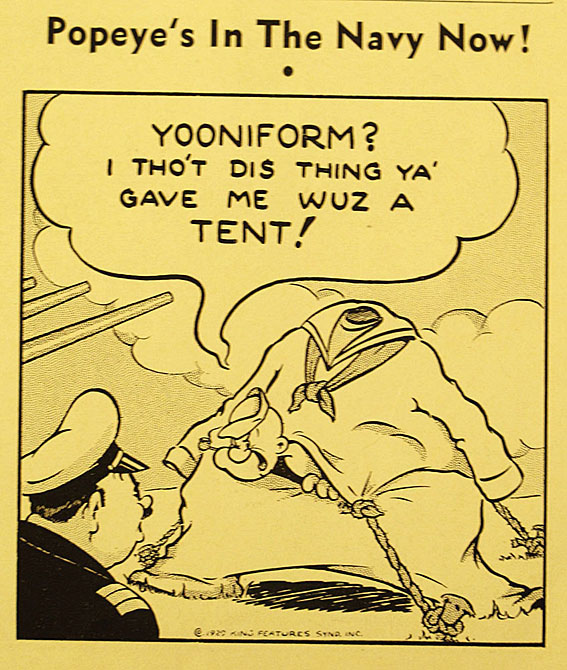
©King Features Syndicate and from the Personal Collection of Fred Grandinetti/Ad courtesy of Cartoon Research
Popeye officially joined the Navy starring in morale boosting cartoons from both the Fleischer & Famous Studios.
When Fleischer Studios moved to Florida, the Popeye series took on a brighter look. The series remained with Paramount Pictures, who financed the production of the cartoons. It was its highest-grossing animated property. Popeye and Bluto would change their attire during this period, wearing white sailor uniforms. This switch reflected U.S. military involvement in world matters. Popeye would, for the most part, remain in his Navy whites throughout the remainder of his career and the majority of the made for TV-Cartoons produced during the early 1960s.
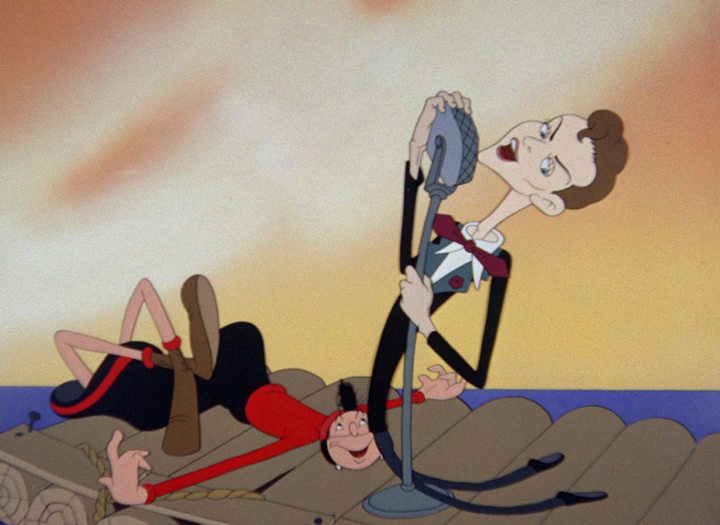
©King Features Syndicate and from the Personal Collection of Fred Grandinetti.
Frank Sinatra rescues Olive Oyl from being stranded on an island in Shape Ahoy (Famous Studios, 1945)
By 1942, Fleischer Studios was deeply in debt to Paramount after their second attempt at a full-length animated film, Mr. Bug Goes to Town, failed at the box office. Paramount moved the animation studio back to New York and renamed it Famous Studios. While Popeye’s popularity remained, many changes were made in the series. In late 1943, the first color theatrical short was released and Popeye’s look-a-like and sound-a-like nephews became regulars in the series. Olive Oyl was given a bit of a cosmetic makeover. She had a fuller hairstyle, high heel shoes and a visible chest! Jackson Beck became the permanent voice of Bluto. While many of the early Famous Studios films are entertaining, by the early 1950s, many stories focused on the Popeye-Olive-Bluto love triangle.
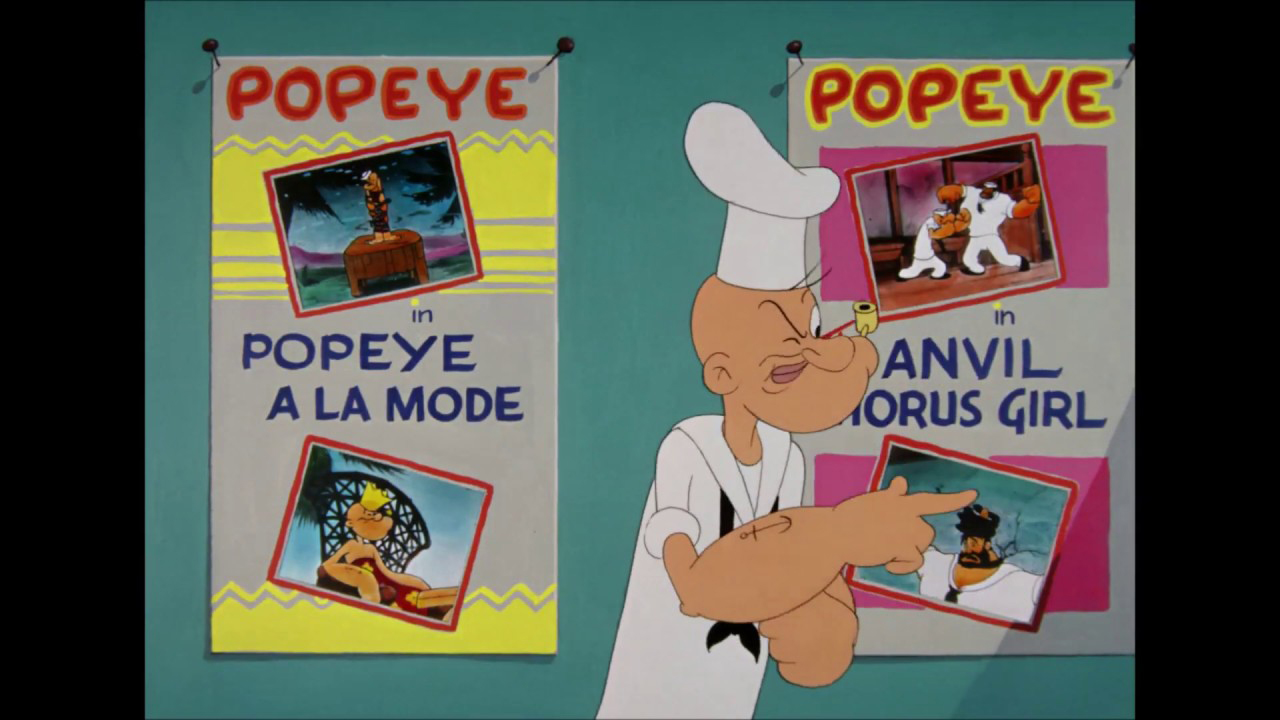
©King Features Syndicate and from the Personal Collection of Fred Grandinetti.
Popeye shows his nephews scenes from the sailor’s previous adventures in Spinach vs Hamburgers (Famous Studios, 1948)
In 1957, Paramount Pictures needed a financial boost and sold the 234 Popeye shorts to Associated Artists Productions for television syndication. To say this sale gave the sailor his second wind would be an understatement. Popeye quickly became the most popular children’s series on the small screen, with the cartoons televised all over the country. A March 20, 1957 advertisement in Variety read: “Spinach rates high with kids when Popeye’s back in town. So does Popeye himself. In 21 cities across the country all markets rated thus far by ARB-Popeye cartoon programs earned a resounding rating of 16.2 on a weekly average, regardless of station, time period or competition.”
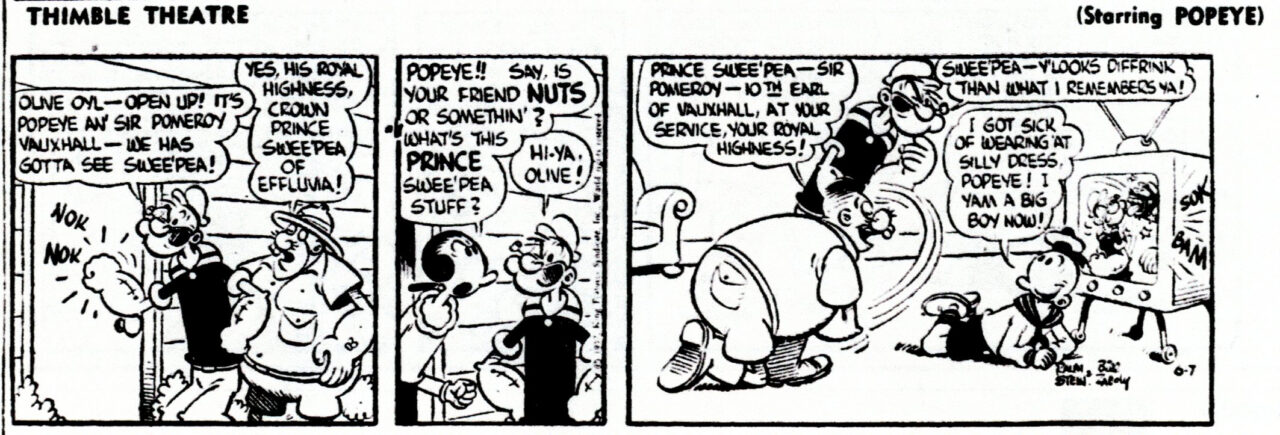
©King Features Syndicate and from the Personal Collection of Fred Grandinetti.
The success Popeye cartoons were having on television was noted in the Thimble Theatre comic strip from June 7, 1957. Look at what Swee’pea is watching on television. By Ralph Stein (writer) and Bill Zaboly (artist).
King Features Syndicate, though owning the rights to the Popeye comic strip, did not share profits with the syndication of the theatrical films. Al Brodax, head of the syndicate’s television division, hired different animation studios to produce a total of 220 Popeye color cartoons primarily during 1960-1962. The personnel involved with these films were Gene Deitch, Larry Harmon, Gerald Ray, Jack Kinney and Seymour Kneitel. Many of the characters from the comic strip, who did not appear in the theatricals, were seen in the television cartoons. These included: King Blozo, Toar, Alice the Goon, Rough House, Geezil, The Sea Hag and her vulture! Due to a dispute over the origins of his name, Bluto became known as Brutus!
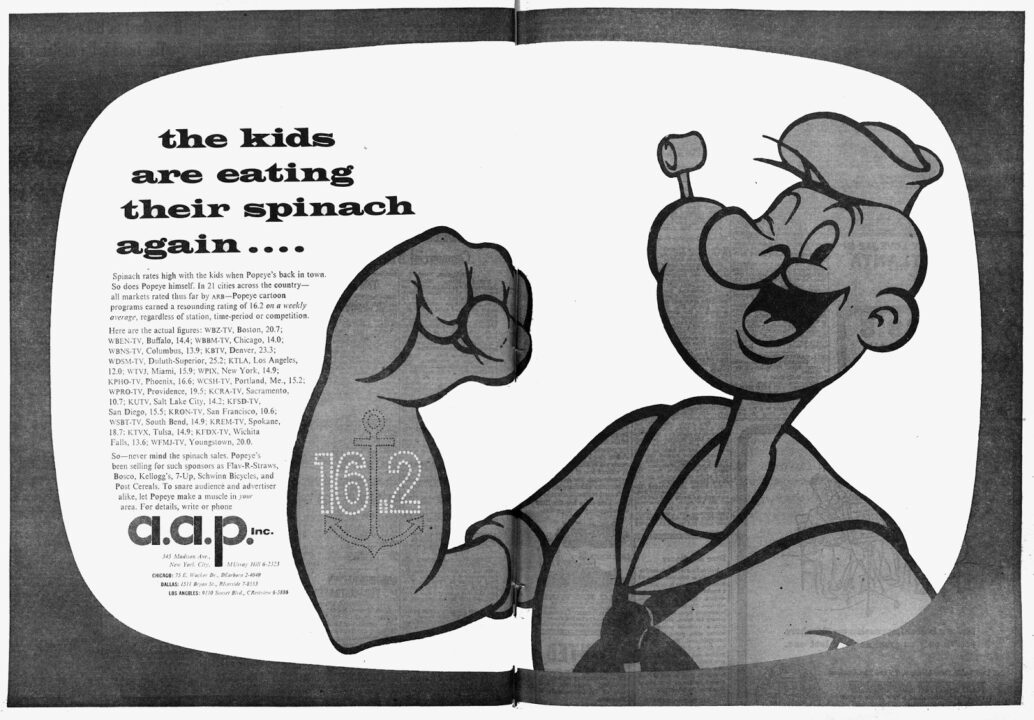
©King Features Syndicate and from the Personal Collection of Fred Grandinetti.
1956 Trade ad from Variety
Because of the change in personnel and the limited production time, the quality of each cartoon ranged from poor to excellent. Many prefer the cartoons produced by Paramount Cartoon Studios under the direction of Seymour Kneitel. That is not to say others are unwatchable. However, several contain animation which is difficult to sit through if you’re over the age of ten. Jack Mercer, Mae Questel and Jackson Beck provided the voices for the characters that appeared in the cartoons.
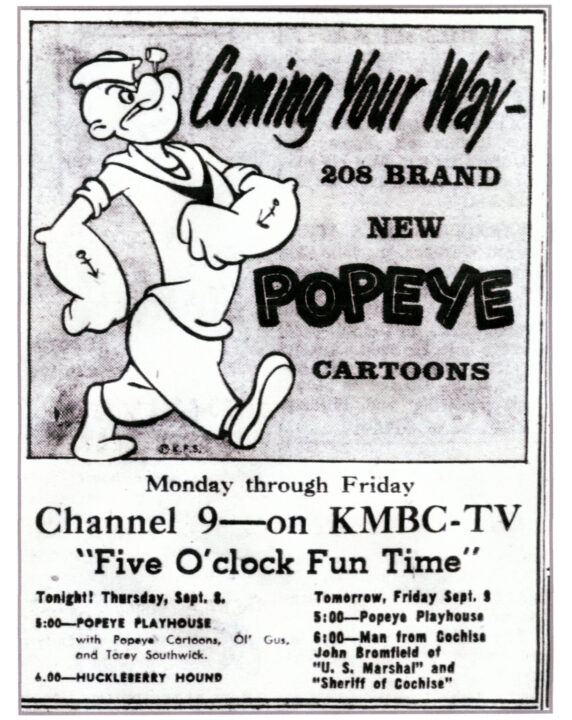
©King Features Syndicate and from the Personal Collection of Fred Grandinetti.
The event of new Popeye cartoons coming to television was big news! From the September 8th, 1960 edition of The Kansas City Times (Kansas City, Missouri),
Despite the series’ flaws they were an overwhelming hit on television. The June 10, 1964 edition of Variety ran the headline “Popeye’s 20,000,000 Gross.” At the time of this article, the Fleischer/Famous Popeye films were syndicated to 190 U.S. stations while the television episodes were sold to 125. Many of these outlets played both the theatrical and made-for-TV versions. By the early 1970s, Popeye’s earnings in newspapers, theaters and TV had grossed over $50,000.000, in addition to the estimated $100,000,000 in Popeye-related merchandise.
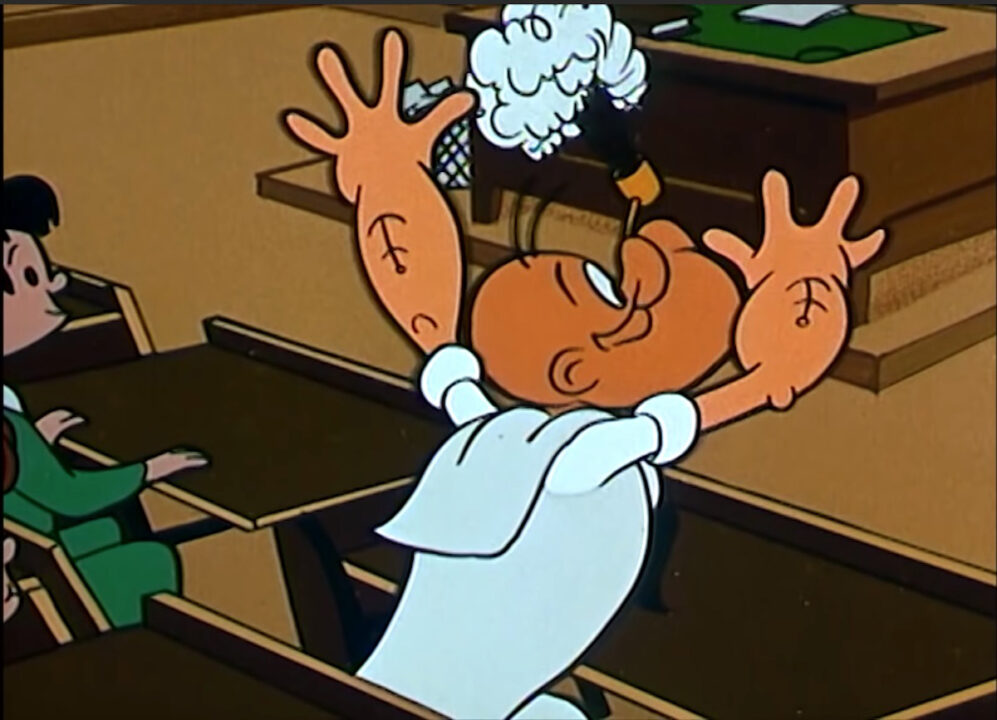
©King Features Syndicate and from the Personal Collection of Fred Grandinetti.
Popeye goes back to school in The Spinach Scholar (Paramount Cartoon Studios, 1960).
Myron Waldman, who animated Popeye during the 1930s and 1940s, brought the sailor to life in a film sent to public schools. 1971’s Look Where You Are Going had Popeye instructing audiences the correct way to cross the street and interact with traffic.
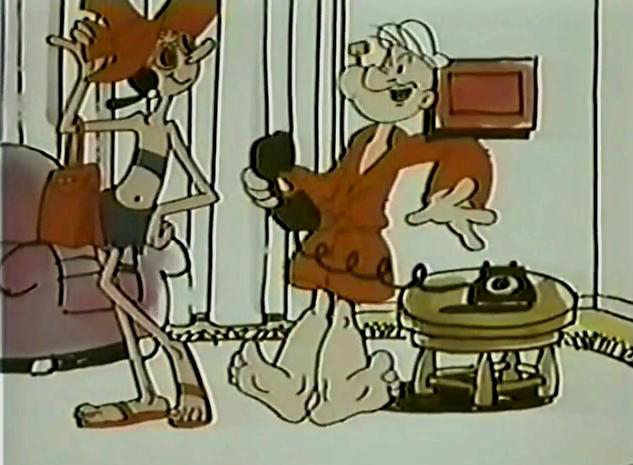
©King Features Syndicate and from The Personal Collection of Fred Grandinetti
Popeye and Olive Oyl from The Man Who Hated Laughter (1972)
In 1972, Popeye, along with several other comic strip characters from King Features Syndicate, appeared in the hour special The Man Who Hated Laughter. This program was an episode in The ABC Saturday Superstar Movie, directed by Hal Seeger and Jack Zander.
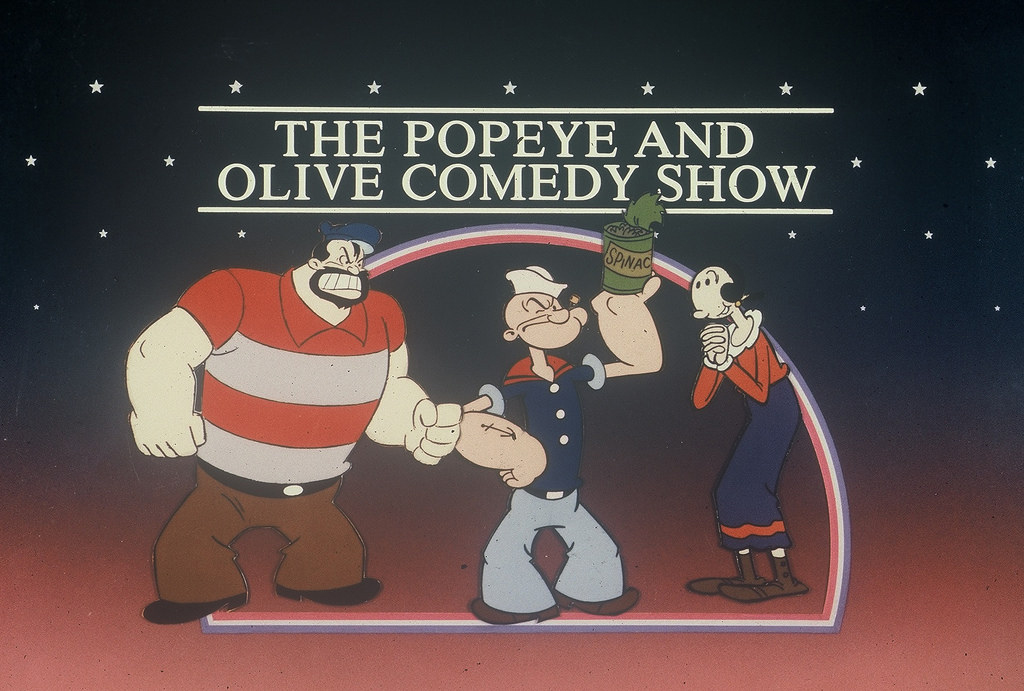
©King Features Syndicate and from The Personal Collection of Fred Grandinetti
Popeye & Olive Comedy Show ran on CBS from 1981-83
For the 1978-79 Saturday morning television season, Popeye and company returned in The All-New Popeye Hour, produced by Hanna-Barbera. Despite the fact that due to network guidelines, Popeye could no longer punch Bluto, there was a sincere attempt to recapture the era of the Fleischer films. Stories would have unpredictable endings and, except for retaining his sailor’s hat, Popeye wore his original attire from the early Fleischer films. Jack Mercer returned to voice the sailor and wrote several of the stories. Marilyn Schreffler supplied Olive Oyl’s vocals and character actor Allan Melvin growled effectively as Bluto.
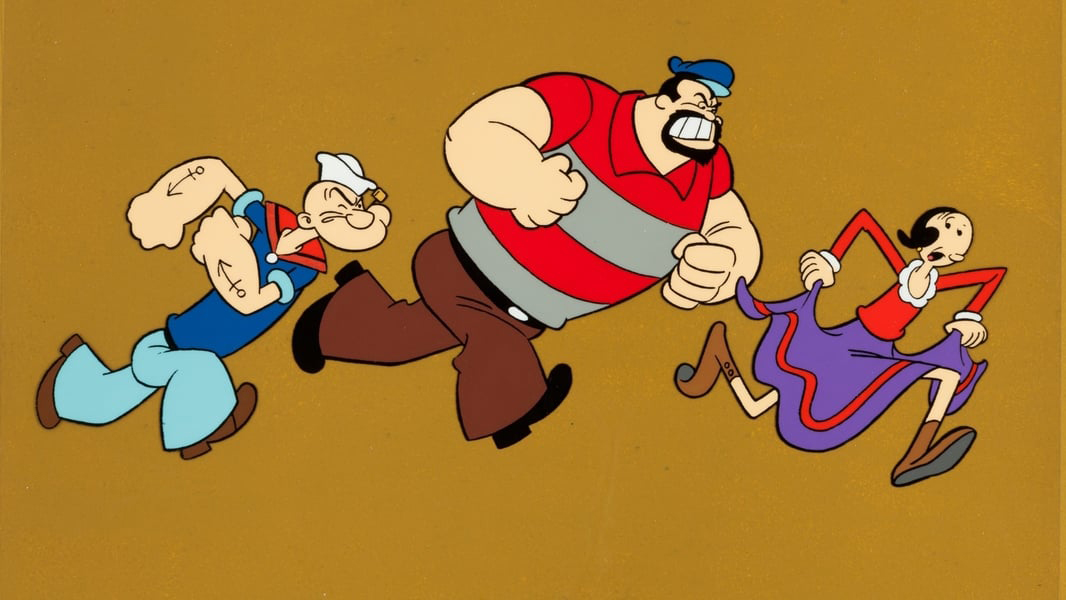
©King Features Syndicate and from The Personal Collection of Fred Grandinetti
Popeye, Bluto and Olive Oyl from The All New Popeye Hour
The program originally consisted of two parts, with Olive acting as Popeye’s equal rather than a damsel in distress. Health and safety tips were sprinkled throughout the hour. The series was so popular it spawned a primetime animated special, The Popeye Valentine’s Day Special-Sweethearts at Sea (1979). From 1981 to 1983 the series became a half hour and was titled The Popeye and Olive Comedy Show. Cartoons had Popeye as a caveman and Olive Oyl in the Army. Olive’s cohort-in-chaos was Alice the Goon!
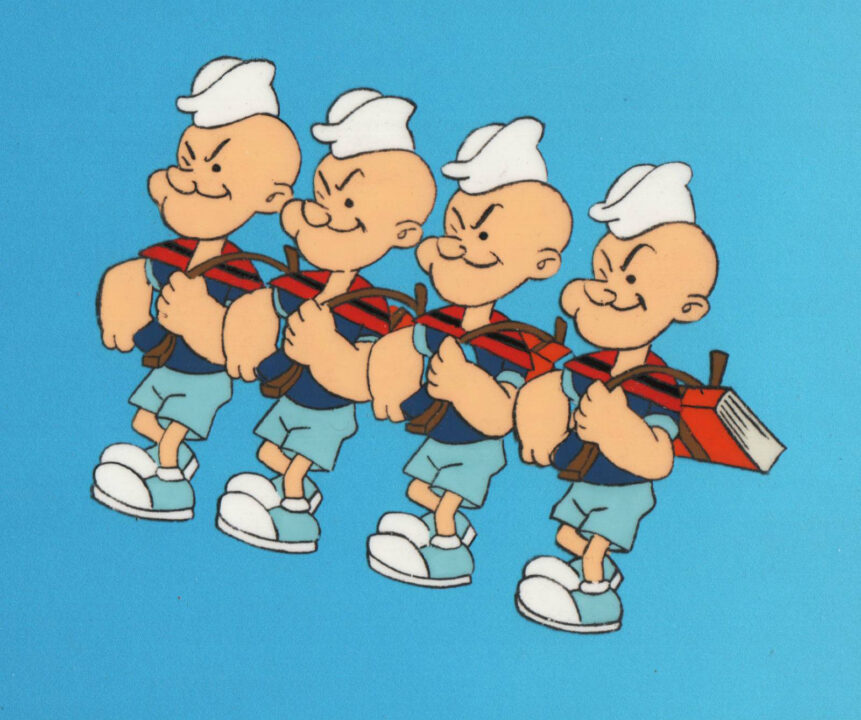
©King Features Syndicate and from The Personal Collection of Fred Grandinetti
Popeye’s Nephews were used in safety tips seen on The All New Popeye Hour
Hanna-Barbera made another attempt animating Popeye but unfortunately this series focused in the sailor’s son from his marriage to Olive Oyl. Popeye and Son aired on the CBS Saturday morning schedule during the 1987-88 season. The one-eyed sailor’s son was a spinach-hating tyke dubbed “Junior.” The classic characters were modernized, with Popeye wearing a loud Hawaiian shirt and Olive donning a gym suit and new hairstyle. Marilyn Schreffler and Allan Melvin returned to perform the voices of Olive Oyl and Bluto while Maurice LeMarche did a passable job as Popeye (Jack Mercer had passed away in 1984). Audiences rejected this updating of the Popeye characters and situations.
With the addition of the 1960-62 television series, All New Popeye cartoons, and the twenty- three Popeye and Son episodes, the scrappy sailor added approximately three hundred more adventures to his film library.
This cartoon, from 1979, has an unusual conclusion. This time Popeye doesn’t save Olive Oyl nor eat his spinach.
During the 1980s and through 1990s, WTBS, TNT and the Cartoon Network aired the theatrical cartoons but the black-and-white originals were terribly colorized. Thankfully the original versions could still be seen on Cartoon Network’s Late Nite Black & White series beginning in 1993. The Popeye Show, an anthology series, debuted on the Cartoon Network in October 2001. An episode included three Popeye shorts and included facts and history of each film. The cartoons had their original opening and closing added. These had not been since their screenings in theaters. Cartoon Network had a bias regarding airing black-and-white cartoons in primetime and debuted this classy series at 1:30am on Monday mornings. The audience complained and the show spent most of its three-year run-on Sunday evenings, first at 9:30pm and later, 7:30pm. 135 cartoons were restored for broadcast on The Popeye Show.
In 2007, Warner Brothers began releasing the Popeye theatricals on DVD, along with a selection of the television cartoons from the 1960s and 1970s.
Whatever medium you choose to watch Popeye, he remains one of the most enduring characters in the field of animation, and a great role model too! Happy 90th anniversary, Popeye!
